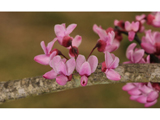
Stunning pink flowers in spring. Visited by native bees for nectar and nesting material.
Tree with short trunk, rounded crown of spreading branches, and pink flowers that cover the twigs in spring. Redbud is a 15-30 ft. tree with one to several picturesque, maroon-purple trunks and a wide, umbrella-like crown. Its pink flowers, borne in tight clusters along the stems and branches before new leaves appear, create a showy spring display. Smooth, heart-shaped, deciduous foliage does not have significant fall color. Trees from the southern part of the species’ range have smaller, glossier leaves and often a more compact form. Stunning tiny pink flower clusters cover the entire tree.
Three geographic varieties are recognized, with Cercis canadensis var. canadensis properly referred to as Eastern Redbud and occurring from the Atlantic coast to central Texas. It reaches the largest size, requires the most water, and has larger, less glossy leaves than the other varieties. Variety texensis, Texas Redbud, has smaller, glossier leaves with slightly wavy edges, a generally smaller form, and more of a tendency to have red seedpods than variety canadensis. It ranges from Oklahoma south through central Texas to northeastern Mexico. The smallest variety is C. canadensis var. mexicana, Mexican Redbud, with small, very glossy, wavy-edged leaves and a smaller, shrubbier stature than the others, occurring in west Texas and adjacent Mexico. All varieties are popular as ornamentals because of their brilliant early spring flowers, displayed en masse on the bare branches before the plant has leafed out. The flowers can be eaten as a salad or fried. A separate species, Cercis orbiculata, Western Redbud, occurs from Arizona to California. According to myth, Judas Iscariot hung himself on the related Judas-tree (Cercis siliquastrum L.) of western Asia and southern Europe, after which the white flowers turned red with shame or blood.
More from USDA Plants Database »